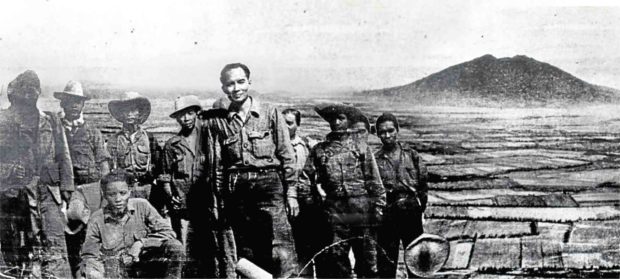Hukbalahap monument to rise in Ecija town

HUK STRONGHOLD Mt. Arayat in the shared boundary of Pampanga, Tarlac and Nueva Ecija provinces was both a fortress and haven to Hukbalahap members led by Luis Taruc (center). PHOTO COURTESY OF CKS-HAU
CITY OF SAN FERNANDO — A park in Cabiao town, Nueva Ecija province, will soon host a monument honoring the Hukbo ng Bayan Laban sa Hapon (Hukbalahap), a peasant-led army that fought the invading Japanese forces during World War II.
It was in Cabiao where the resistance army was formed on March 29, 1942.
The town government has committed to reserve a land for the monument planned by Holy Angel University’s Center for Kapampangan Studies (CKS), said Robby Tantingco, CKS executive director.
The park spans 2,000 square meters at Barangay Sta. Rita. Many Huks belonging to Squadron 55 had settled in the village, according to Jose Hipolito, the town’s planning and development officer and nephew of several Huks.
Unsung heroes
Article continues after this advertisement“Local govenment officials of Cabiao showed me the development area where two monuments will be put up—one for a local hero and another for the Hukbalahap,” Tantingco said.
Article continues after this advertisement“Finally, we will have a monument for the unsung heroes of World War II. The Holy Angel University has committed to help Cabiao build this war memorial.”
The National Historical Commission of the Philippines (NHCP) earlier installed a marker at a public elementary school in Cabiao in 2017 for the 75th founding anniversary of Hukbalahap.
According to the NHCP, the subvillage of Bawit in Barangay Bagong Silang (then called San Julian) was the birthplace of Hukbalahap, which it described as a “big and successful guerrilla movement in Central Luzon and other parts of North Luzon.”
Bawit was part of a forest in Mt. Arayat which the Japanese set on fire to flush out guerrillas.
Communist link
Hukbalahap fought 2,000 battles against the Japanese Imperial Army in a war that claimed 20,000 lives between 1942 and 1945. Japan surrendered to allied forces on Sept. 2, 1945.
Cabiao is near Arayat town in Pampanga. The Kapampangan language is still spoken there.
During the Huk’s 77th anniversary this year, representatives of the old Communist Party of the Philippines (CPP) honored the former guerrillas. The CPP, founded in 1930, merged with the Socialist Party of the Philippines and formed the Hukbalahap. It later became the Hukbong Mapagpalaya ng Bayan.
Tantingco said the Huks’ affiliation with the communists and socialists was the excuse the Philippine and United States governments used to deny them their recognition as war heroes and their pension after the war.
Only the Banal Regiment was recognized for its ties to the United States Armed Forces in the Far East. The Philippine Veterans Affairs Office has reproduced and put online the Philippine archives collection, which included guerrilla files.
Surviving Huks fought hard to claim their war pensions, which the government began releasing in 1976 although the amounts, they said, were a pittance.
The CKS has campaigned for the national recognition of the Hukbalahap’s heroism. It cohosted a national conference for the 75th anniversary of World War II in the Philippines and produced the movie “Aria,” a story of a Huk commander who struggled to get back her pension.